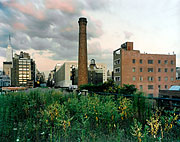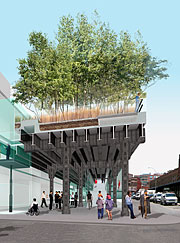Interview with Anne Pasternak, Amanda Burden, and Robert Hammond
On the occasion of the exhibition, “The Plain of Heaven,” Anne Pasternak talks with two leading authorities on the site’s plans for redevelopment, Amanda Burden and Robert Hammond, about the inspiration for the show, artistic interventions, balancing ideologies, visual truth, and the underside of the High Line…
ANNE PASTERNAK: While planning “The Plain of Heaven,” an exhibition that explores artists’ interests in transformation, longing for inaccessible spaces, and the ways in which we construct meaning from the spaces we already know, it seemed meaningful to talk with both of you about the site that inspired the show, the High Line. For years artists have dreamt of making interventions on this site. Since you have been leaders in advocating for its preservation and reuse, I’m curious what you believe are some of the most interesting considerations for artists.
ROBERT HAMMOND: It was an artist’s vision of the High Line that helped build momentum for its redevelopment. Since the High Line is currently closed to the public and we were limited by how often we could show people the site, we wanted to have a “money shot,” an image we could use to familiarize the public with the area. We turned to artist Joel Sternfeld, whose photographs became a way of letting people gain access to the elevated railway in a more imaginary way.
PASTERNAK: I think Joel Sternfeld’s photographs, as distant as their perspectives can be, allow the viewer to project his or her own reality and imagine being in the environment. Yet whatever the site becomes will be very different from our fantasies at this moment, no matter how successful the design is. In a New Yorker article, Adam Gopnik quoted you, Robbie, as saying that “the weird thing is that the High Line is just a structure, it’s just metal in the air, but it becomes a sight for everybody’s fantasies and projections.” I wonder if the High Line, once it’s redeveloped, can still be an idea space in the way that it is today.
AMANDA BURDEN: That’s the greatest challenge facing the design team: to keep it an idea space and to let people’s imaginations be free, and also preserve freedom for artists to intervene at different points in time. That is the issue for any architect, because most will embrace a project and give it a finite solution. The goal here is to create a design that allows people to see the space in different ways.
PASTERNAK: Gordon Matta-Clark stated that “there is a kind of complexity that comes from taking an otherwise completely normal, conventional, albeit anonymous situation, and redefining it, retranslating it.”
HAMMOND: Matta-Clark is a real inspiration for the High Line. It’s his cuttings that I most love. He carved out sections of an abandoned architectural structure, exposing a part of a building to celebrate the building. One of his best cuttings was on the Gansevoort Pier, which was an abandoned piece of industrial infrastructure, a block away from the High Line.
Almost all the designers that we considered for the High Line’s redevelopment talked about Matta-Clark’s approach of working through the structure, of cutting into it. The High Line lends itself to that sort of intervention because it is already cut—it was partly demolished by developers. Where it ends at Gansevoort and Washington Streets, it is sliced open, with many of its layers exposed.
PASTERNAK: People have many strong beliefs in what this site could and should be. Some people want the site maintained as a wild prairie, while others want it to be an icon of the futuristic urban park. Is it possible to achieve a balance between the diverse and often contradictory ideologies?
BURDEN: One thing that totally captures people’s affection and imagination is the fact that the High Line is a floating green space in the sky. It’s a verdant and unkempt landscape, an opportunistic landscape, and that must be retained. We want people to experience that. To preserve this concept of a magic carpet, the proposed pedestrian pathways have to be subservient to the landscape. This will be a real challenge.
HAMMOND: The contradictions of the green among the steel and concrete of the city is captivating. That it exists on another elevation, thirty feet above street level, is just so unlikely. It makes the High Line like a dream. The idea that nature has made a place for itself up there is one of the things people love—that it’s not planted, it’s not watered. Originally there was no dirt. But the dust of the city accumulated enough to grow wildflowers, grasses, and other plants.
BURDEN: The High Line is also a linear experience, an experience of movement. And so, too, must the design be about movement. That’s its heritage. It was a railroad, a structure that moved things. But any linear experience cannot just be linear. It has to have acupuncture, interventions at certain intervals to change the experience. And the extent to which it does that and how often is an important consideration.
PASTERNAK: The High Line is a linear experience, but it’s also like an interior space as it is sandwiched between buildings, creating a corridor effect. Some would argue this condition might recommend a “city as gallery” or urban model for plop art. Others feel its unique condition suggests other types of experiences and interventions, those that are changing and expanding our experience of place.
BURDEN: I want to be completely surprised. I want the art to be something that I haven’t ever imagined.
HAMMOND: We’re just now starting to think about what kind of art we want to see on the High Line, and a lot of people say they don’t want to see “pedestal art.” I favor more experiential art.
BURDEN: I think that’s absolutely correct. Even though it’s a long linear experience, the adjacencies are very different. Every time you cross over a street, you have unobstructed views to the east and west. As the High Line crosses over 10th Avenue, that’s another experience. As you pass through the former meatpacking plant on 14th Street, you are completely enclosed, which is actually one of my favorite experiences, because you feel like you’re in a cave and then you see light coming through. The spurs where the High Line dead-ends at a building are incredibly beautiful. Each one of these experiences provides a special opportunity for an artist to imagine something new. Then there is the underside of the High Line. People may not think of it as magical because everybody’s very familiar with it. In fact, they’re so familiar with it that many people don’t know that it’s the High Line.
PASTERNAK: People romanticize the space as a kind of natural wilderness. Robert Smithson rejected watered-down notions of Victorian naturalism and preferred a kind of art that embraces the mundane, industrial, even messy conditions of real-life environments. How do you deal with that other side of the High Line? How do you deal with its rust and its remnants that some romanticize and others abhor?
HAMMOND: The design team approached the project as a celebration of the architecture that’s there. And the architecture that’s there is that gritty piece. You have the Hudson River alongside this steel structure with all its I-beams, rivets, and rail lines running through it. And what attracted a lot of people to the neighborhood in the first place is that industrial feel. But for some in the community, the High Line was a reminder of an aspect of their neighborhood that they never liked. When the trains traveled along its tracks, church services had to halt, schools had to halt—everything rattled and dust fell. Some people who lived in Chelsea then don’t remember the trains so romantically.
PASTERNAK: What might be your approach to communicating the site’s history, whether it’s a history of labor, industry, transportation, or the broader histories of the neighborhood?
HAMMOND: This is something we’re just now starting to think about. Rather than having a lot of historical markers that tell you the history at different points, I’d like to see the structure itself convey its own its history—that it’s here, that this unique industrial artifact is cutting through the city, connecting us to another time in our city.
BURDEN: A related preservation issue is the graffiti on and around the High Line. It is spectacular. When we were up there the last time we wondered, Should we keep this? Should we photograph this? I feel enormously passionate about the High Line the way it is now. But should it be spic-and-span, or should it be true to its histories, and if so, which ones?
PASTERNAK: Matthew Coolidge, of the Center for Land Use Interp-retation, recently said that “a sense of connection with a place is a form of truth. A visual truth, a ground truth. It can embody conflicting judgments all at once. Maybe you come away with more of a motive or psychological proof, a more complex and complete sense of the place.” I’m interested in what truths you hope people will walk away with after they visit the High Line.
BURDEN: I think you fall in love with the city when you’re there because you see it from a completely different perspective. At this vantage point, you are more aware of texture and scale. You’re close enough to people to see them on the street. I feel the deep affection for the city from this perspective. Maybe that’s just personal, but it’s very profound.
HAMMOND: For me it’s about the scale. When you see the city from the Empire State Building, you see this grand grid and huge buildings. But when you’re thirty feet up on the High Line, the city below actually looks quainter and simpler. The architecture of Chelsea hasn’t changed that much over time, although parts of West Chelsea are going to change in the near future. But that’s one of the great things: you’re going to witness some neighborhoods transforming and other neighborhoods looking pretty much the same.
The High Line embodies both of these worlds—preservation of the past and change for the future. I originally thought of the High Line as an art piece or a dream, but inherently it’s neither of those things—it’s a steel structure with a concrete bathtub and a lot of weeds growing on top. It’s about what it’s imbued with and what people want to imagine it to be.
Amanda Burden is Chair of the City Planning Commission, and Director of the Department of City Planning
Robert Hammond is Co-Founder of Friends of the High Line
Anne Pasternak is President and Artistic Director of
Creative Time
��

Joel Sternfeld, An Evening in July, 2000��


Field Operations and Diller Scofidio + Renfro, Renderings of new design for High Line, 2004����


